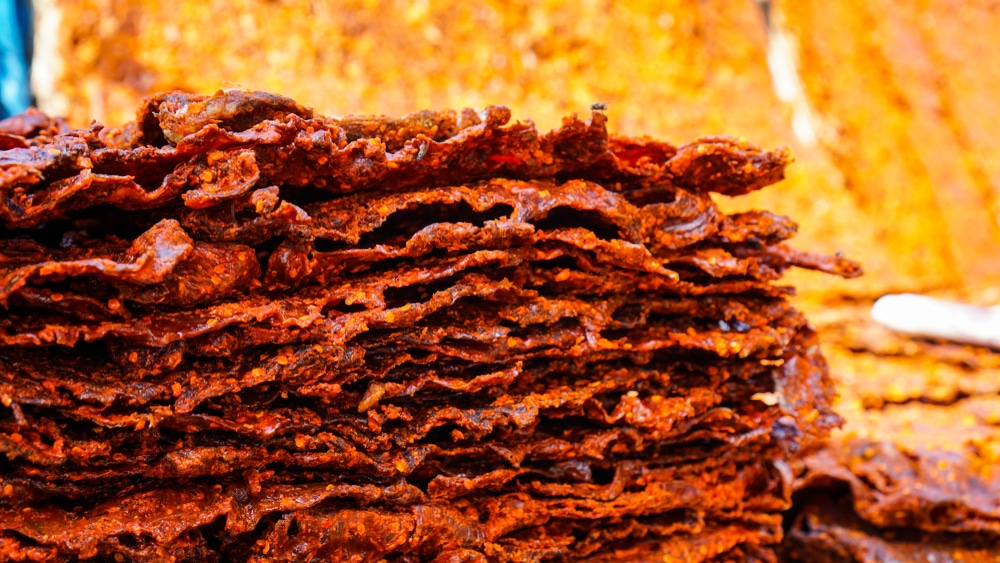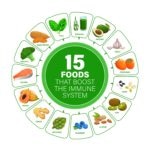These pieces of dry crispy meat coated in a layer of the spicy mixture were served in a saucer with soft drinks (soda) to go with it. That was the first time I tasted kilishi and I loved it so much that I secretly wished I could get more of it. The fear of embarrassment deterred me from being an Oliver Twist. Our host later wrapped some of it in an old newspaper and offered it as a gift, my joy knew no bounds.
What is kilishi?
Historically originating from Northern Nigeria, kilishi is cow meat that has been dried and coated with a spicy paste/ mixture called labu. Kilishi is prepared by curing, an ancient method of meat preservation. The meat is soaked in a mixture of salt and spices and then placed under the sun to dry. Initially, this dry curing method was only a way of preserving large amounts of cow meat in households of the Hausas and nomadic Fulanis.
However, with the advent of socialization and industrialization, kilishi production has become a booming business as it is now produced in commercial quantities for sale to customers in different parts of the country and the world. The drying process drastically reduces moisture and increases the shelf life. It has been one named Nigerian beef jerky.
Types of kilishi

Kilishi is majorly made with beef (cow meat). However, mutton (sheep/lamb meat) and chevon (goat meat) have been used as well. If you want to buy kilishi made from other meat, then you have to specifically request it. Consumers seem to prefer beef kilishi, which is the most popular. Mutton kilishi popularly called Balangu in Hausa Language contains more calcium, magnesium and sodium compared with beef kilishi. Beef kilishi on the other hand has higher iron content than balangu kilishi for an equivalent weight of either meat.
How to prepare kilishi?
The hot dry weather in the north makes preparation and storage convenient. First, the meat is deboned and cut into long thin pieces.
This is dried, soaked in the spicy paste, and dried again. This drying process reduces the moisture in the meat thereby improving the shelf life. It also reduces the conducive moist environment in which infectious bacteria grows.
The spicy paste contains salt, onions, seasoning, cloves, cayenne pepper, black pepper, curry, and desiccated groundnut cake.
How to properly store kilishi
The method of storage and the season of the year determines the shelf life of this delicious snack. In most places, it is sold well packaged in brown papers, plastic take-out plates, or brown envelopes.
One study found that there was a markedly increased growth of germs on Kilishi samples stored in papers when compared to that stored in high-density polyethylene, the material used in making plastic bottles and take-out plates.
I recall having some packed in a brown paper bag with which we returned to the hot humid Weather of the south. By the time we brought it out, it wasn’t crispy anymore and the coating had become soft and sticky. Kilishi certainly has a longer shelf life in the hot dry Northern cities of Nigeria.
Since environmental factors such as high humidity can reduce its shelf life, it can be dried further in an oven in such environments.
Is it healthy to eat kilishi?
If not properly stored some parts of it may have moulds growing on them. This stale kilishi is certainly not healthy for consumption.
In some places, the drying of the meat is done on slabs in an open space, and flies perch on the meat like bees in a beehive. Contaminants and germs are easily introduced in the process from flies and unhygienic handling, which makes it a source of food poisoning. This means that improper storage and preparation methods can make it unhealthy for consumption.
However there are places where this stage is done in a more hygienic way. The drying chamber is in an open space, built with chicken house wire and protected with nets such that flies can not enter the drying area. You could warm it up in an oven if you are unsure about hygienic preparation.
Salt and nitrates used in kilishi meat preservation has high sodium content and if overtly seasoned, this can cause your body to retain excess water which is not healthy for your kidneys. If you have a high BP, or a heart condition, it can worsen the symptoms. Moderate consumption of this tasty crunchy meat is best. Better still, find where you can get one that is minimally seasoned/ salted.
Does kilishi contain sugar?
The standard spice mixture does not contain sugar. It is best to ask the vendor if sugar was added during preparation.
Is Killishi safe in pregnancy?
Spicy and attractive as it is, kilishi can trigger heartburn and abdominal pain particularly in the third trimester when the size of the baby has pushed your stomach up.
Women with pregnancy induced hypertension, hypertension or preeclampsia should avoid highly seasoned kilishi because its high sodium content will interfere with Blood pressure (BP) control. A poorly controlled BP can result in other complications of elevated BP such as stroke, kidney failure, heart failure, etc.
In summary, kilishi is a great source of animal protein and a convenient snack that can be eaten alone or alongside other meals or snacks. Prepared under hygienic conditions, with minimal salt and seasoning, kilishi is a healthy snack.




